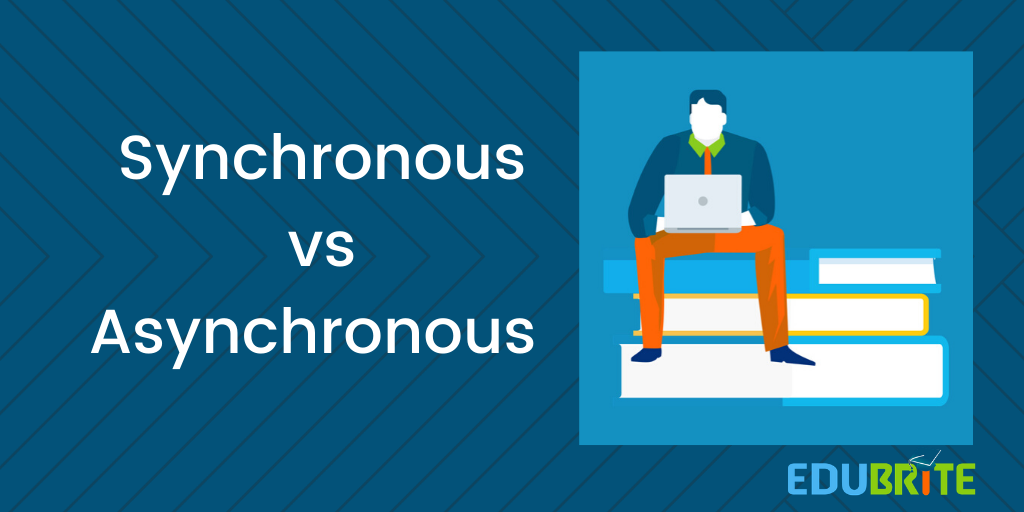Synchronous vs. Asynchronous Learning
When planning a training strategy for meeting learning and business objectives, there are two modes of delivery you must consider: synchronous and asynchronous. So which one is better? Ideally, what works best for the content, the instructor, and the participants is the model used. However, there are likely many more factors that will go into choosing between synchronous and asynchronous learning. It’s best to understand the nuances of both so you can choose the right approach to meet objectives while also working within your constraints.

What is Synchronous Learning?
Synchronous learning refers to a real-time, scheduled learning experience where a group of people are all participating at the same time. Whether the experience is happening in person or remotely, participants and facilitators are able to interact with each other instantaneously. Learners ask questions and receive feedback right away. Because synchronous learning happens live, peer-to-peer or group activities are possible as well.
Synchronous learning may come in the form of the following:
- Live webinars
- In Person Classroom Training
- Instant messaging
- Virtual Instructor Led Training
- Chat rooms
- Video conferencing
In the business setting, synchronous learning often takes place during onboarding for new company processes, systems, policies, software, etc. This type of learning can also be used for client and customer training, where Q&A’s take place and feedback is provided right away.
What is Asynchronous Learning?
Asynchronous learning is the opposite of synchronous. In asynchronous learning the participant completes courses on their own, at their own pace, and from any location. It can be in both online and offline forms.
Participants in an asynchronous course may still have access to instant feedback and answers, not from an instructor, but from ELearning Content delivered through an LMS. Asynchronous learning is self-paced, thus dynamic group activities are not possible. The instructor and the students interact on their own time.
Asynchronous learning takes the form of the following:
- Self Guided ELearning Courses
- Pre-recorded video lessons or webinars
- Demonstration videos
- li>Blogs
- Online discussion boards
- Online collaborative projects
What are the Pros and Cons of Synchronous and Asynchronous Learning?
Each category comes with their respective advantages and disadvantages:
| PROS | CONS | |
| Synchronous learning | · Interaction. Synchronous learning happens in real-time, allowing for simultaneous interaction among learners and facilitators. · Immediate feedback. Live and real-time classes allow for free-flowing insight and idea exchange. Learners can get answers to their questions right away. · Rich discussions. Being present with other learners allows for more insights and opinions during the class, enabling critical-thinking and further exchange of ideas. |
· Scheduled. Synchronous learning is not as flexible since it essentially happens in an online classroom. Learners have to show up at a specified time. However, classes can be recorded so those who are not available can still access the material. · Divided attention. Some learners may not get the chance to ask questions due to the presence of other participants. Some may also be too shy to come forward with their questions. To address this, some facilitators could encourage them to ask through the chatbox, and allow one question each until everyone has been covered. · Delivery of content. The success of synchronous learning depends on how well the facilitator delivers the course content. Some learners may want a certain kind of delivery over others, and if not satisfied, may prefer to consume the material by themselves. |
| Asynchronous learning | · Flexibility. A strong quality of this category is the ability for self-paced learning. While there may still be deadlines, asynchronous learning allows participants to consume the course content anytime, anywhere. Time zones and locations won’t matter as much. · Deep learning. Asynchronous learners will have more time to absorb and thoroughly go through the course content given the significant amount of time provided to them. · Fewer distractions. Going through the lessons alone means asynchronous learners could focus on their own thought patterns and get rid of the distractions from other participants’ questions and opinions. |
· Waiting time. Since asynchronous learning is not real-time, learners would have to wait for instructors to get to their questions and insights. This may be addressed by using an LMS that provides accessibility and easy communication features. · Isolation. Going through course materials alone may create a feeling of isolation, or provide less motivation in completing the course at the right pace. Great and interactive content and LMS delivery methods can address learner isolation. |
When to use Synchronous and Asynchronous Training
To find out whether synchronous or asynchronous works best for your content and your learners, ask the following questions:
- What are your learning objectives?
- What is the course content to be covered?
- Is the facilitator’s delivery style a good fit for the learners?
- Where are your learners located?
- What is the learners’ availability like?
- How you deliver most of your training based on the availability of your learners?
In The End
It isn’t always easy to choose between synchronous and asynchronous approaches. But with a better understanding of both, you are prepared to weigh the pros and cons. You may also want to consider blended both approaches, often referred to as blended learning.
EduBrite makes it easy to implement synchronous, asynchronous and blended learning through various features and integration with tools such as WebEx, Zoom, GotoMeeting/Webinar, ReadyTalk integrations for live ILT events, Google and Outlook Calendar.
To learn more, book a demo with us now.
